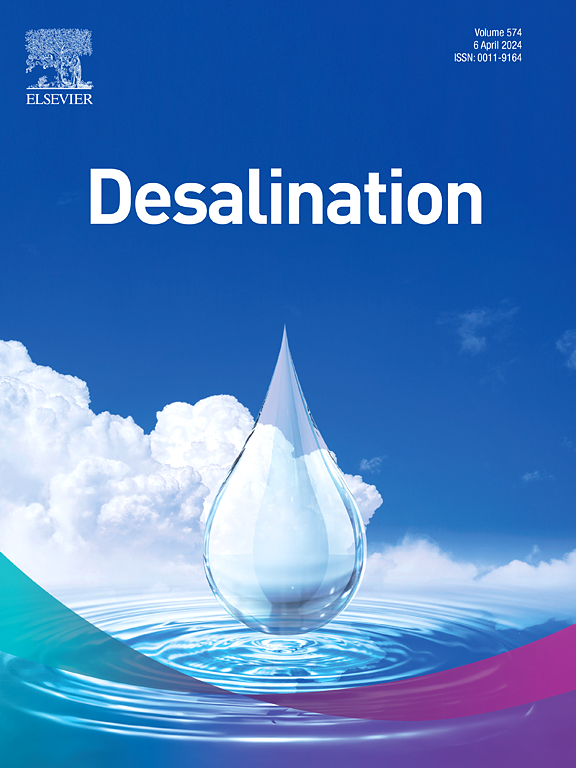Manipulating π electron behavior of graphene for remarkable solar steam generation and salt recovery
IF 8.3
1区 工程技术
Q1 ENGINEERING, CHEMICAL
引用次数: 0
Abstract
Solar steam generation is of interest as a promising and sustainable technology in response to global water scarcity and energy scarcity. Despite great effort is continuously dedicated to exploiting powerful materials and excellent configurations, the synchronous modulation of electron behavior on both the solar absorption and the assembly of photothermal materials is still less well addressed for outstanding solar steam generation. Herein, the π electrons of graphene are finely manipulated by varying the C/O (sp2/sp3) ratio, which further regulates the π-conjugate network on the graphitic plane, and then tunes the 3D self-assembly. A combined experimental and theoretical investigation is firstly conducted on the effects of π electron tuning on the solar absorption and photothermal conversion property of deoxidized graphene oxide (dGO), as well as the solar interfacial evaporation and salt recovery performance of dGO aerogels: 1) dGO with a high C/O ratio exhibits a sizable π–conjugate network, reducing the band gap, leading to a mean solar absorbance as high as 97.6 %; 2) A dGO aerogel π–π self-stacked by dGO nanosheets with a C/O ratio of 4.63 affords the best balance between the water adsorption and heat insulation, yielding an extraordinary evaporation rate of 5.82 kg m−2 h−1 under one sun of irradiation; 3) A “U” shaped dGO aerogel is well designed to recover salt with a rate up to 0.374 kg m−2 h−1 as well as long–term evaporation performance. This work opens an effective route to design high–efficiency solar interfacial evaporators which especially has vital reference significance for carbonaceous and polymer–based photothermal materials.

操纵石墨烯的π电子行为,用于显著的太阳能蒸汽产生和盐回收
太阳能蒸汽发电作为一种有前途的可持续技术,在应对全球水资源短缺和能源短缺方面引起了人们的兴趣。尽管人们不断努力开发强大的材料和优秀的结构,但在太阳能吸收和光热材料的组装上电子行为的同步调制仍然没有得到很好的解决,以实现出色的太阳能蒸汽发电。该方法通过改变C/O (sp2/sp3)比对石墨烯的π电子进行精细操纵,进而调控石墨平面上的π共轭网络,从而调控三维自组装。首先对π电子调谐对脱氧氧化石墨烯(dGO)的太阳吸收和光热转换性能以及dGO气凝胶的太阳界面蒸发和盐回收性能的影响进行了实验和理论结合研究:1)高C/O比的dGO具有相当大的π共轭网络,减小了带隙,平均太阳吸收率高达97.6%;2)碳氧比为4.63的dGO纳米片自堆叠的dGO气凝胶在吸水性和绝热性之间达到了最佳平衡,在一个太阳照射下的蒸发速率达到了5.82 kg m−2 h−1;3)设计了一种“U”型dGO气凝胶,回收盐的速率可达0.374 kg m−2 h−1,并具有长期蒸发性能。本工作为设计高效的太阳界面蒸发器开辟了一条有效途径,尤其对碳质和聚合物基光热材料具有重要的参考意义。
本文章由计算机程序翻译,如有差异,请以英文原文为准。
求助全文
约1分钟内获得全文
求助全文
来源期刊

Desalination
工程技术-工程:化工
CiteScore
14.60
自引率
20.20%
发文量
619
审稿时长
41 days
期刊介绍:
Desalination is a scholarly journal that focuses on the field of desalination materials, processes, and associated technologies. It encompasses a wide range of disciplines and aims to publish exceptional papers in this area.
The journal invites submissions that explicitly revolve around water desalting and its applications to various sources such as seawater, groundwater, and wastewater. It particularly encourages research on diverse desalination methods including thermal, membrane, sorption, and hybrid processes.
By providing a platform for innovative studies, Desalination aims to advance the understanding and development of desalination technologies, promoting sustainable solutions for water scarcity challenges.
 求助内容:
求助内容: 应助结果提醒方式:
应助结果提醒方式:


